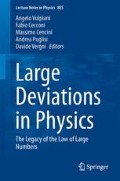Abstract
After a brief introduction to the main equilibrium features of long-range interacting systems (ensemble inequivalence, negative specific heat and susceptibility, broken ergodicity, etc.) and a recall of Cramèr’s theorem, we discuss in this chapter a general method which allows us to compute microcanonical entropy for systems of the mean-field type. The method consists in expressing the Hamiltonian in terms of global variables and, then, in computing the phase-space volume by fixing a value for these variables: this is done by using large deviations. The calculation of entropy as a function of energy is, thus, reformulated as the solution of a variational problem. We show the power of the method by explicitly deriving the equilibrium thermodynamic properties of the three-state Potts model, the Blume-Capel model, an XY spin system, the ϕ 4 model and the Colson-Bonifacio model of the free electron laser. When short range interactions coexist with long-range ones, the method cannot be straightforwardly applied. We discuss an alternative variational method which allows us to solve the XY model with both mean-field and nearest neighbor interactions.
Access this chapter
Tax calculation will be finalised at checkout
Purchases are for personal use only
References
T. Dauxois, S. Ruffo, L. Cugliandolo, Long-Range Interacting Systems (Oxford University Press, Oxford, 2010)
A. Campa, T. Dauxois, S. Ruffo, Statistical mechanics and dynamics of solvable models with long-range interactions. Phys. Rep. 480, 57 (2009)
F. Borgonovi, G.L. Celardo, M. Maianti, E. Pedersoli, Broken ergodicity in classically chaotic spin systems. J. Stat. Phys. 116, 1435 (2004)
D. Mukamel, S. Ruffo, N. Schreiber, Breaking of ergodicity and long relaxation times in systems with long-range interactions. Phys. Rev. Lett. 95, 240604 (2005)
J. Sak, Recursion relations and fixed points for ferromagnets with long-range interactions. Phys. Rev. B 8, 281 (1973)
F.J. Dyson, Existence of a phase-transition in a one-dimensional Ising ferromagnet. Commun. Math. Phys. 12, 91 (1969)
D. Ruelle, Statistical mechanics of a one-dimensional lattice gas. Commun. Math. Phys. 9, 267 (1968)
H. Touchette, The large deviation approach to statistical mechanics. Phys. Rep. 478, 1 (2009)
J. Barré, D. Mukamel, S. Ruffo, Inequivalence of ensembles in a system with long-range interactions. Phys. Rev. Lett. 87, 030601 (2001)
R.S. Ellis, The theory of large deviations: from Boltzmann’s 1877 calculation to equilibrium macrostates in 2D turbulence. Physica D 133, 106 (1999)
M. Blume, Theory of the first-order magnetic phase change in UO 2. Phys. Rev. 141, 517 (1966); H.W. Capel, On the possibility of first-order phase transitions in Ising systems of triplet ions with zero-field splitting. Physica 32, 966 (1966)
R. Desai, R. Zwanzig, Statistical mechanics of a nonlinear stochastic model. J. Stat. Phys. 19, 1 (1978)
R. Bonifacio, F. Casagrande, G. Cerchioni, L. De Salvo Souza, P. Pierini, N. Piovella, Physics of the high-gain FEL and superradiance. Riv. Nuovo Cimento 13, 1 (1990)
G. Robb, Collective instabilities in light-matter interactions, in Long-Range Interacting Systems, ed. by T. Dauxois, S. Ruffo, L. Cugliandolo (Oxford University Press, Oxford, 2010), p. 527
F. Leyvraz, S. Ruffo, Ensemble inequivalence in systems with long-range interactions. J. Phys. A: Math. Gen. 35, 285 (2002)
T. Mori, Microcanonical analysis of exactness of the mean-field theory in long-range interacting systems. J. Stat. Phys. 147, 1020 (2012)
O. Cohen, D. Mukamel, Ensemble inequivalence: Landau theory and the ABC model. J. Stat. Mech.: Theory Exp. P12017 (2012)
Author information
Authors and Affiliations
Corresponding author
Editor information
Editors and Affiliations
Rights and permissions
Copyright information
© 2014 Springer-Verlag Berlin Heidelberg
About this chapter
Cite this chapter
Patelli, A., Ruffo, S. (2014). Large Deviations Techniques for Long-Range Interactions. In: Vulpiani, A., Cecconi, F., Cencini, M., Puglisi, A., Vergni, D. (eds) Large Deviations in Physics. Lecture Notes in Physics, vol 885. Springer, Berlin, Heidelberg. https://doi.org/10.1007/978-3-642-54251-0_7
Download citation
DOI: https://doi.org/10.1007/978-3-642-54251-0_7
Published:
Publisher Name: Springer, Berlin, Heidelberg
Print ISBN: 978-3-642-54250-3
Online ISBN: 978-3-642-54251-0
eBook Packages: Physics and AstronomyPhysics and Astronomy (R0)

